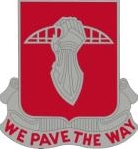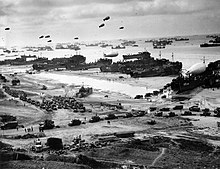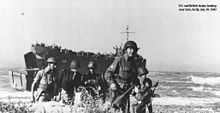
The VII Army Corps of the United States Army was one of the two principal corps of the United States Army Europe during the Cold War. Activated in 1918 for World War I, it was reactivated for World War II and again during the Cold War. During both World War II and the Cold War it was subordinate to the Seventh Army, or USAREUR and was headquartered at Kelley Barracks in Stuttgart, West Germany, from 1951 until it was redeployed to the US after significant success in the Gulf War in 1991, then inactivated in 1992.

A pontoon bridge, also known as a floating bridge, uses floats or shallow-draft boats to support a continuous deck for pedestrian and vehicle travel. The buoyancy of the supports limits the maximum load that they can carry.
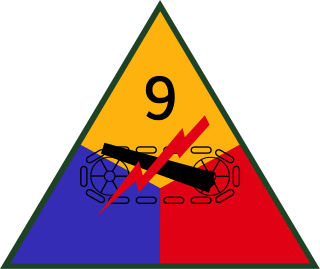
The 9th Armored Division was an armored division of the United States Army during World War II. In honor of their World War II service, the 9th was officially nicknamed the "Phantom Division."
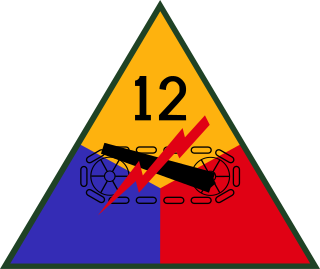
The 12th Armored Division was an armored division of the United States Army in World War II. It fought in the European Theater of Operations in France, Germany and Austria, between November 1944 and May 1945.
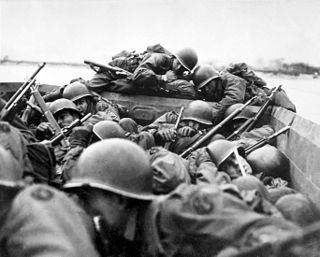
Operation Plunder was a military operation to cross the Rhine on the night of 23 March 1945, launched by the 21st Army Group under Field Marshal Bernard Montgomery. The crossing of the river was at Rees, Wesel, and south of the river Lippe by the British Second Army under Lieutenant General Miles Dempsey, and the United States Ninth Army under Lieutenant General William H. Simpson.
The 741st Tank Battalion was an independent tank battalion that participated in the European Theater of Operations with the United States Army in World War II. The battalion participated in combat operations throughout northern Europe until V-E Day. It was one of five tank battalions that landed in Normandy on D-Day. It landed on Omaha Beach supporting the 1st Infantry Division, but was attached to 2d Infantry Division on 15 June 1944, which it supported for most of the remainder of the war. The battalion played a key role in blunting the northern flank of the German attack during the Battle of the Bulge in December 1944. The 741st Tank Battalion advanced as far as Plzeň, Czechoslovakia by the end of the war.
The 9th Engineer Battalion is a unit of the United States Army that deploys to designated contingency areas and conducts combat and/or stability operations in support of a brigade combat team. It is a divisional mechanized combat engineer unit, composed of three line companies and a headquarters company. Its mission is to provide assured mobility, counter-mobility, general engineering, and survivability support, with well trained sappers ready to deploy anywhere at any time. The unit's history spans service in 1917 in the US southwest, World War II in France and Germany, multiple deployments to the Balkans, and multiple deployments in support of the global war on terrorism in Iraq and Afghanistan. It is most famous for the capture of the Ludendorff Bridge across the Rhine River. As of 18 May 2015, the battalion exists as the 9th Brigade Engineer Battalion in Fort Stewart, GA under 2nd Armored Brigade Combat Team, 3rd Infantry Division.
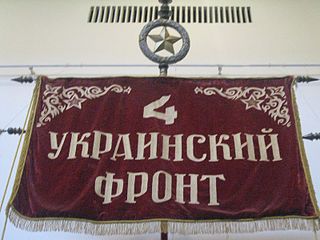
The 4th Ukrainian Front was the name of two distinct Red Army strategic army groups that fought on the Eastern Front in World War II.

The 22nd Armoured Brigade was an armoured brigade of the British Army that saw service during and after the Second World War. The brigade was formed on the outbreak of war on 3 September 1939 from Territorial Army (TA) armoured regiments. It saw a considerable amount of action during the war, beginning with the Western Desert Campaign where it was engaged in Operation Crusader and at the Battles of Gazala, Mersa Matruh, First Alamein and Alam el Halfa. It then joined the 7th Armoured Division for the Second Battle of El Alamein. It remained part of 7th Armoured for the rest of the war, including the campaigns in Tunisia, Italy and North West Europe. It continued in the postwar TA until 1956. The brigade's identity was re-established in the Regular Army between 1981 and 1993.
The 607th Tank Destroyer Battalion was a tank destroyer battalion of the United States Army active during the Second World War. They arrived in England during April, 1944, and entered combat in mid June, landing at Utah Beach. The unit fought across France and into Germany during the summer and early winter of 1944. In late winter, they were then pulled out and sent to Belgium near the end of the Ardennes Campaign and again fought their way into and across Germany, ending the war near the Czechoslovakian border. The 607th received credit for the Normandy, Northern France, Rhineland, Ardennes-Alsace and Central Europe campaigns.
The 628th Tank Destroyer Battalion was a tank destroyer battalion of the United States Army active during the Second World War. It was redesignated the 628th Tank Battalion after the end of the war, and today exists as the 103rd Armor Regiment.
The 612th Tank Destroyer Battalion was a unit of the United States Army during World War II. It played an instrumental role in defending Hofen during the Battle of the Bulge. The specialized tank destroyer unit was attached to various organizations during the war. In December, 1944, the twelve 3-inch guns of Company A were integrated into the defensive positions of the 395th Infantry Regiment and were key to keeping the attacking Sixth Panzer Army from gaining essential objectives in the first days of the offensive.

The 743rd Tank Battalion was an independent tank battalion that participated in the European Theater of Operations with the United States Army in World War II. It was one of five tank battalions which landed in Normandy on D-Day. The battalion participated in combat operations throughout northern Europe until V-E Day. It was inactivated on 27 November 1945.
The 82nd Armored Reconnaissance Battalion was a part of the 2nd Armored Division, and was activated July 15, 1940, at Fort Benning, Georgia, for World War II. The organization was made up of trained men, from cavalry and reconnaissance units. The reconnaissance battalion was known as the "eyes and ears", of the 2nd Armored Division.

The 291st Engineer Combat Battalion was one of the most decorated engineer combat battalions of the United States Army during World War II, playing notable roles both in the Battle of Bulge and the Rhine river crossing at Remagen.

The 289th Engineer Combat Battalion was a combat engineer battalion of the United States Army during World War II. It served under XXI Corps of the Seventh Army in action mainly in France and Germany in 1944 and 1945. It received campaign credit for participation in the Ardennes-Alsace campaign , Rhineland campaign, and the Invasion of Germany.

The 549th Engineers Light Pontoon Company was a combat engineer company of the United States Army during World War II. Operationally attached to the 1150th Engineer Combat Group, it served under XXI Corps of the Seventh Army in action in France and Germany in 1944 and 1945.

Camp Bouse was a secret camp of the US Army, Desert Training Center in Mohave County, Arizona. Camp Bouse is located 25 miles (40 km) from Bouse, Arizona, just north of Arizona State Route 72 and about 50 miles (80 km) north of Interstate 10.

The 1139th Engineer Combat Group was a technical United States Army Headquarters Unit providing administration and supervision support to Combat Engineers on bridge building and other construction activities during World War II. The 1139th Engineer Combat Group was part of the Third Army and was attached for operations to the XX Corps in direct support of the 7th Armored Division. The 1139th Engineer Combat Group fought from northern France to Austria in World War II, supporting General George Patton's Third Army's rapid movements during the war.

